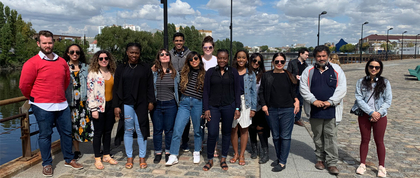
Pictured Above: GPH students at the Matanza-Riachuelo River Basin (left to right) Clayton Richardson, Maura Harris, Amanda Llaneza, Tricia Blackman, Camille Jordan, Justin Singh, Senti Sojwal, Kat Anderson, Nerline Louis, Parris Lloyd, Yogeeta Kuldip, Architects Cecilia Alvis and Gustavo Cañaveral, and Aria Chitturi.
Saludos!
During Spring Break, 12 students and I traveled to NYU Buenos Aires for a course called Environmental Injustice: From Local to Global. We created a classroom without walls or borders, examining the historical, political, economic and social aspects of environmental injustice in Argentina – and witnessed firsthand how environmental degradation occurs and is institutionally reinforced.
Over six days we traversed the city and provinces, from the Argentine Pampas to local barrios, where we observed variations on land use and the built environment. Through fieldwork, didactic, and applied training, the principles of environmental justice -- public good over profit, cooperation over competition, collective action over individualism and precautionary approaches over unacceptable risks -- were transformed from the written page to the lived experience.
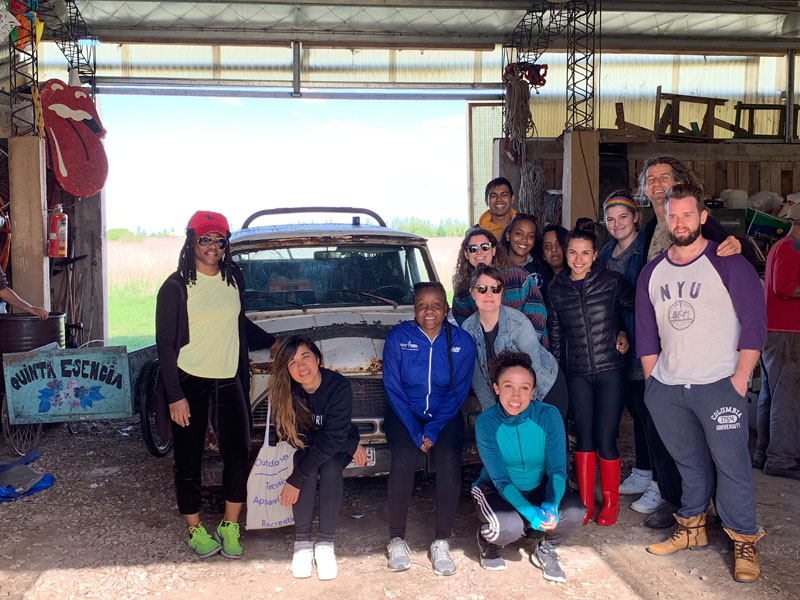
Picture 1: Students at Quinta Esencia Eco-Villiage (from left to right) Tricia Blackman, Senti Sojwal, Nerline Louis, Maura Harris, Camille Jordan, Amanda Llaneza, Justin Singh, Parris Lloyd, Yogeeta Kuldip, Aria Chitturi, Kat Anderson, Eduardo Tiscornia, and Clayton Richardson.
Our journey began with a workshop led by the director of Amartya, a local NGO that promotes the concept of a sustainable Argentina. Then we traveled to the Pampas and stayed overnight in an “eco-house” to learn about sustainable living and ecological preservation. From composting to planting seeds and harvesting food, to workshops on sustainable development, biodiversity and permaculture, to natural wastewater treatment, renewable energy and thermodynamics -- even endangered honeybees! – we saw links between the movements for environmental justice and international sustainable development.
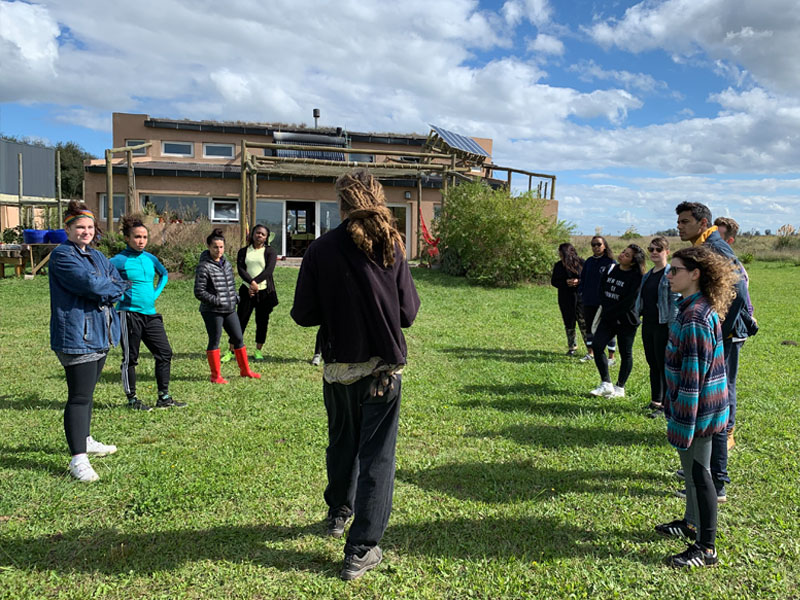
Picture 2: Students at Quinta Esencia Eco-Villiage learning about thermodynamics and permaculture (from left counter clockwise) Kat Anderson, Maura Harris, Aria Chitturi, Tricia Blackman, Yogeeta Kuldip, Parris Lloyd, Senti Sojwal, Camille Jordan, Clayton Richardson, Justin Singh, Amanda Llaneza, and Quinta Esencia Director, Eduardo Tiscornia.
The next two days were spent with architects Cecilia Alvis and Gustavo Cañaveral, who taught us about toxic site remediation along the Matanza-Riachuelo River -- one of the most polluted in the world -- and the role architects are playing in its clean-up and revitalization.
On our final day, we toured several communities including Villa Inflamable, a shantytown five kilometers from Buenos Aires, which is surrounded by petrochemical companies and was declared uninhabitable in 2008 by the Argentine Supreme Court. Villa Inflamable’s residents lack potable water (the Argentine government provides each household with three gallons of water per day); garbage lines many streets, and uncovered cesspools can be found in backyards. A grassroots community organization, Sembrando Juntos, fights along with 1,800 other families for clean air, water and land. They remain hopeful and believe that the government will rectify this environmental injustice.
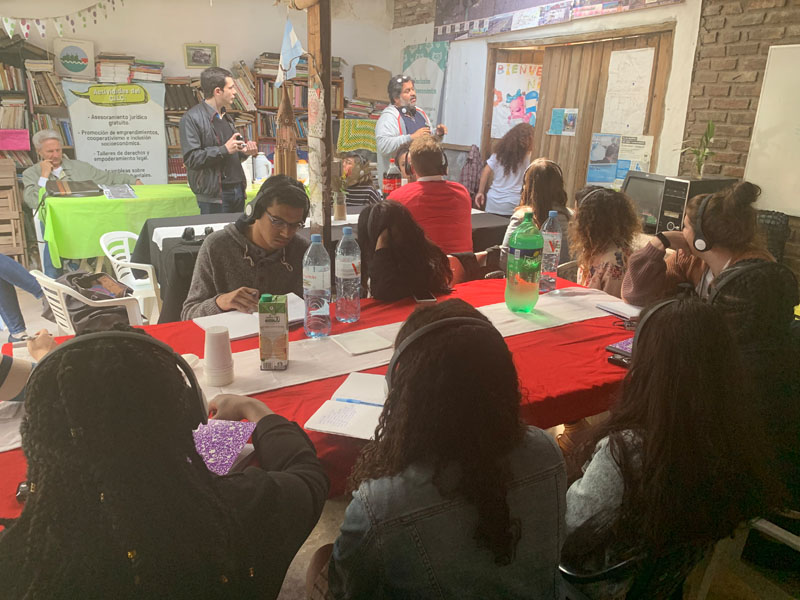
Picture 3: Students at local community based organization Sembrandos Juntos in Villa Inflamable
During a debrief on our final day back at NYU BA, one student began to cry -- and then we all began to cry. The students cried because the struggle for environmental justice had become undeniably real. I cried because I was so proud of them, and because I knew they would never be the same or forget what they had learned.
Only at NYU BA could a course like this have been developed and implemented, and for that we are eternally grateful. It will be offered again in Fall 2019 as part of the curriculum for the GPH Cross-Continental MPH.
In solidarity,
Beverly-Xaviera Watkins, PhD, MS
Clinical Associate Professor in Social Epidemiology
The Environmental Injustice Class Members (listed below)
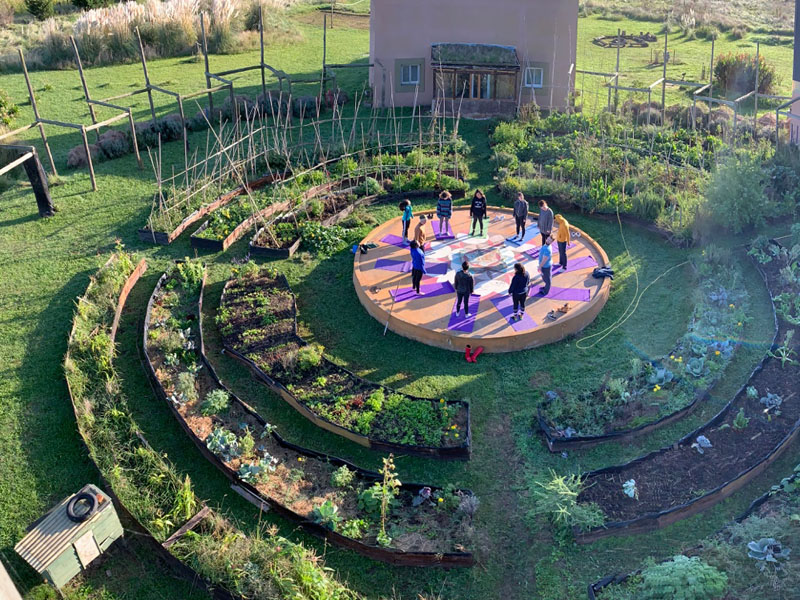
Picture 4: Students in Yoga Class at Quinta Esencia Eco-Villiage (from left center counter clockwise) Aria Chitturi, Nerline Louis, Instructor, Maura Harris, Amanda Llaneza, Senti Sojwal, Camille Jordan, Kat Anderson, Justin Singh, and Clayton Richardson
Co-Authors:
Clayton Richardson, MPH Candidate, Epidemiology
Buenos Aires is the fifth NYU Global site I’ve traveled to -- and the most thought-provoking. The contrasts are stark; the city is filled with ornate marble buildings and metal-clad slums. Classism and racism force people of low status to be exposed to dangerous levels of lead, mercury and pathogenic bacteria. The plight of these people and the inhumane treatment they endure will be forever etched in my memory -- as will the hospitality and courage we were shown by those championing their cause and fighting for their rights.
Yogeeta Kuldip, MPH Candidate, Health Policy
The inhumanity of environmental injustice left me speechless; I was looking at it through a telescope but this class showed me the whole picture. I felt really saddened at the world we live in and the life these people continue to endure. They’re fighting every day for basic human rights that are stripped away from them, and I felt a need to do something like I’ve never felt before. I left with unforgettable memories, and a determined mind and heart to hopefully one day be a part of a solution.
Senti Sojwal, MPH Candidate, Community Health
It was eye-opening to see the city's largest slum next to its most expensive neighborhoods, and observe how toxicity plagues the water and air quality. Along with the complex interactions among economics, environmentalism, and sustainability issues, I left with a greater understanding of the resilience of local organizers in working toward a better future.
Maura Harris, MPH Candidate, Health Policy
Our time in BA gave us a true look at environmental activism, spanning the interpersonal and policy levels. Quinta Esencia eco-house was a beautiful experience in permaculture and sustainability, and the architects and policy experts who showed us their work in, and for the communities surrounding the Riachuelo River were an inspiring example of dedication.
Amanda Llaneza, MPH Candidate, Epidemiology
I witnessed the differences between the conservation and sustainability movements, and the need for them to unite for the greater cause of environmental justice. Buenos Aires was invaluable to understanding the lectures and readings in the classroom, and how they applied to policy and intervention methods in the real world.
Nerline Louis, MPH Candidate, Global Health
In Buenos Aires I saw how our own actions -- and those of corporations -- pollute the environment and damage community health. The people most impacted have low socioeconomic status, and they lack the power to fight adverse conditions. So much needs to be done to provide a healthy environment for all and achieve the Sustainable Development Goals by 2030.
Camille Jordan, MPH Candidate, Global Health
Our trip to Argentina was a highlight of my time at NYU. Studying the polarity of environmental exposures in Buenos Aires was an experience that I will take with me throughout my career in public health, as I examine the complex relationship between environment, human health, politics, and industry in new contexts. The grassroots organizations working for social and environmental justice in Argentina were motivating examples of how we can all push back against global superpowers and complacency to fight for healthier communities.
This intensive, experiential learning course was designed in partnership with Vilma Irazola, director of the Institute for Clinical Effectiveness and Health Policy at Buenos Aires (IECS); Dr. Anna-Kazumi Stahl, director of NYU Buenos Aires; and Bernadette Boden-Albala, director of the GPH Cross-Continental MPH, interim chair of the Department of Epidemiology, and senior associate dean for research.
Mil Gracias a: Christian de Amartya; Eduardo, Ramon, Pablo, Ariel, y Ana de Quinta Esencia; Gustavo y Cecilia de Proyecto-DES-LIMITES; Sebastian de ACIJ; Maria de Sembrandos Juntos; Sharon Robert for GPH Global Programs, and Paul Holzman and Carolina Bois for NYU BA.
Also, thank you to Gbenga Ogedegbe, Associate Vice Chancellor for Global Network Academic Planning, and Deputy Provost C. Cybele Raver for providing intellectual and financial resources through a Global Network University grant.